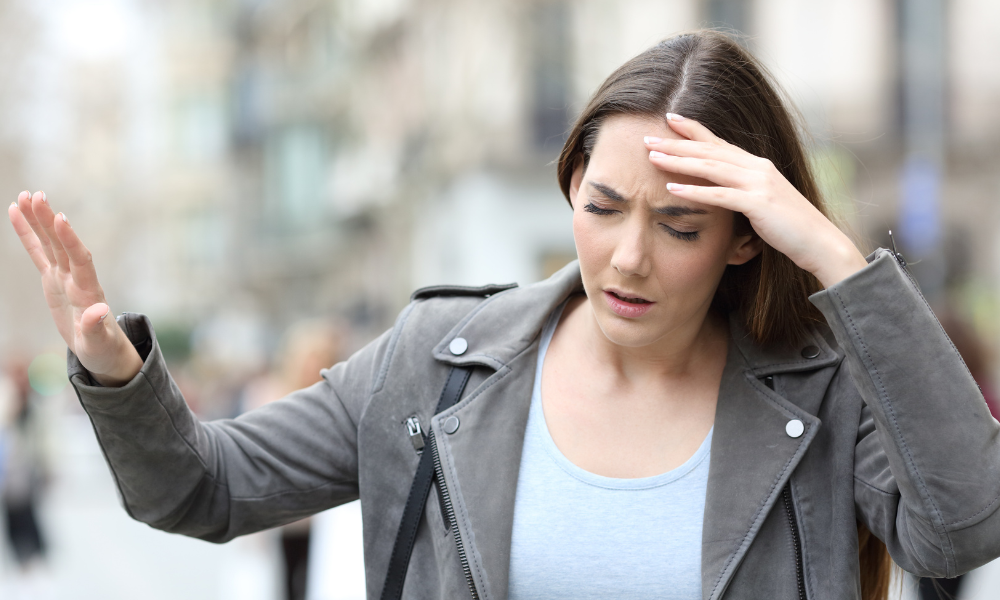Dizziness
Move Better. Live Fuller. Your Wellness Journey Starts Here.
Schedule a FREE Discovery Call!
About Dizziness
Dizziness is a common symptom found in a variety of conditions. It is described as a feeling of being off-balance, unsteady, or lightheaded.
Other related symptoms that may be accompanied by dizziness include confusion and disorientation. All of these symptoms can contribute to falls and or other injuries by making it difficult to maintain balance.
Dizziness is often confused with vertigo. Vertigo is a very similar symptom that creates spinning sensations even when you are standing still, which can cause nausea and vomiting. It can be accompanied by other symptoms that affect balance, too. Vertigo and dizziness can occur together, especially when the cause is a neurological or vestibular condition.

The severity and frequency of your dizziness depend on the cause of your symptoms. It may present itself as an occasional symptom, or may be something that occurs regularly. When symptoms like dizziness or vertigo occur frequently, they may indicate a condition that requires specialized care to manage. Therefore, those who experience dizziness frequently or regularly should seek treatment to lower their risk of injury.
What Causes Dizziness?
Dizziness occurs when something disrupts your balance. Balance can be affected by many different factors, even things such as alcohol, anxiety, anemia, and medications. Additionally, there are many parts of the body that control or affect balance, such as your vestibular system, nervous system, muscles, and joints. When these structures experience dysfunction, it can cause dizziness and other symptoms.
Your vestibular system is located within the inner ear. It sends important information to the brain, such as your head’s position and movement. Your eyes provide visual information, and your joints and muscles send information about their position and movement, too.
All of these inputs are quickly processed by the brain, which allows it to understand your position and movement in relation to the things around you. Thanks to all these different systems working together, you can maintain balance and move around safely.
However, as mentioned before, these areas can experience damage or dysfunction, which causes dizziness and other symptoms to occur. Problems with these parts of the body are common, and are often due to neurological or vestibular conditions such as the following:
Concussions
One of the most common symptoms following a concussion is dizziness. Although many individuals have their symptoms fade in a few weeks, some may experience recurrent dizziness as a result of post-concussion syndrome. This is typically due to damage of the brain or vestibular system.
Balance Issues
Balance and dizziness go hand-in-hand. When you are off-balance, you may feel dizzy. When you feel dizzy, you may become more off-balance. There are actually many different conditions and factors that can affect balance, which you can read about on our balance issues page!
Vestibular Migraines
In some cases, individuals may have a predisposition for vestibular migraines. These are headaches that cause dizziness and other vestibular symptoms, and may or may not present other symptoms of actual headaches. They can be triggered by certain factors, such as food, hormones, or stress.
BPPV
BPPV is a vestibular condition affecting the inner ear. It is a common condition that significantly affects balance, and causes symptoms of dizziness, vertigo, disorientation, and more. It is caused by the displacement of crystals within the inner ear that help detect position and movement.
Labyrinthitis
This condition is a type of inner ear infection that causes inflammation of a structure called the labyrinth. This inflammation disrupts sensory signals from communicating with the brain, causing dizziness and problems with balance.
Meniere’s Disease
This is a disorder affecting the vestibular system. Meniere’s disease causes symptoms of dizziness, hearing loss, and vertigo. It typically occurs in one ear, and its root cause is unknown.
Vestibular Neuritis
This condition refers to dysfunction of the inner ear nerve in charge of transferring signals from the vestibular system to the brain. This dysfunction is due to irritation or inflammation of the nerve, usually caused by viral infections. Vestibular neuritis can affect balance and cause symptoms like dizziness and peripheral vertigo.
Physical Therapy for Dizziness
Unfortunately, dizziness is not a symptom that you can always easily prevent. While finding out causes such as medications or anemia can help you prevent dizziness, other underlying conditions will need to be identified and treated by a provider.
It is especially important to seek diagnosis and treatment when you are unsure of the cause of your dizziness—as it is a symptom that can put you in danger of injury from falls and loss of balance. It can make daily tasks like using stairs, driving, or working more difficult or dangerous as well. As mentioned before, dizziness can also be indicative of neurological conditions.
Physical therapy can manage dizziness and neurological conditions through rehabilitative treatments, strengthening, education, and more. Treatment for dizziness can depend on the cause, but may include the following examples:
Vestibular Rehabilitation
For dizziness caused by vestibular conditions, specific forms of rehabilitation may be necessary. Vestibular rehabilitation manages conditions such as BPPV, labyrinthitis, and more. It looks to improve balance and strength through specific activities curated to the patient’s vestibular disorder. This can include activities such as canalith repositioning, habituation, gaze stabilization, and more—all of which you can read more about on our vestibular rehabilitation page!
Balance and Coordination Training
No matter the cause of your dizziness, improving your balance and coordination can be very beneficial in lowering your risk of injury. Balance can be improved just like any other skill through practice and exercise.
Your physical therapist can lead you through a variety of exercises to improve your balance and coordination. These exercises will counteract the loss of balance often experienced with different conditions. With their supervision and teaching, you can safely and steadily improve your balance and reduce your risk of falls!
To further improve balance and counteract dizziness, your physical therapist may lead you through proprioceptive training. Proprioception is your body’s natural ability to understand its position and movement in space. It gives you spatial awareness and balance, but can worsen due to age or certain conditions. Proprioceptive training can improve your balance and reduce your risk of injury, so your physical therapist is likely to include this type of training in your care plan, too.
Strengthening and Stretching
Strengthening your body and improving your flexibility can significantly improve your balance and prevent injury. This is because strengthening your body not only helps better prepare you in the case of a fall (being better able to catch yourself or prevent the fall), but it also enhances proprioception.
Additionally, having a strong and flexible body reduces your risk of fractures and other injuries. Your bones, muscles, and other soft tissues will be strong and mobile, making them less susceptible to injury or strain. Strong bones and muscles will improve your balance and stability, too—allowing you to better manage uneven terrains or surfaces encountered during daily life. All of these factors support a safer and higher quality of life!
Therefore, your physical therapist will work to improve your core and lower body strength, as well as the range of motion and flexibility of your joints. They’ll achieve this through a curated exercise and stretching plan that is specific to your body and unique needs.
Education and Home Strategies
Education plays a significant role in treatment of any condition or symptom, including dizziness. Your physical therapist has extensive knowledge and experience with a range of conditions and symptoms! They’ll be able to help you better understand your condition, why you feel off-balance or dizzy, and how you can better manage your symptoms with treatment in the clinic and at-home practice.
Your physical therapist will send you home with an exercise plan and other strategies to support long-term health and safety. They may suggest modifications to your home or work environment that will allow you to better manage your symptoms and lower fall risk, or teach you how to use mobility aids if necessary.
As you can see, there are many ways your Hive physical therapist can address your dizziness and other symptoms. While we have listed some specific examples here, there are many other treatments available at Hive Therapy and Wellness. Hive’s providers value comprehensive care, meaning they will use a variety of treatments that best meet your needs and health goals. While working with Hive, you may experience any of the following treatment methods:
- Neuromuscular re-education
- Manual therapy
- Exercise prescription
- Dry needling
- Cupping
- Tissue scraping
- Behavioral modifications
- Therapeutic activities
- Electrical muscle stimulation
- Spinal manipulation
- Therapeutic modalities
- Biofeedback
Dizziness is a common symptom found in a variety of conditions. It is described as a feeling of being off-balance, unsteady, or lightheaded.
Other related symptoms that may be accompanied by dizziness include confusion and disorientation. All of these symptoms can contribute to falls and or other injuries by making it difficult to maintain balance.
Dizziness is often confused with vertigo. Vertigo is a very similar symptom that creates spinning sensations even when you are standing still, which can cause nausea and vomiting.
It can be accompanied by other symptoms that affect balance, too. Vertigo and dizziness can occur together, especially when the cause is a neurological or vestibular condition.
The severity and frequency of your dizziness depend on the cause of your symptoms. It may present itself as an occasional symptom, or may be something that occurs regularly.
When symptoms like dizziness or vertigo occur frequently, they may indicate a condition that requires specialized care to manage.
Therefore, those who experience dizziness frequently or regularly should seek treatment to lower their risk of injury.
Dizziness occurs when something disrupts your balance. Balance can be affected by many different factors, even things such as alcohol, anxiety, anemia, and medications.
Additionally, there are many parts of the body that control or affect balance, such as your vestibular system, nervous system, muscles, and joints. When these structures experience dysfunction, it can cause dizziness and other symptoms.
Your vestibular system is located within the inner ear. It sends important information to the brain, such as your head’s position and movement.
Your eyes provide visual information, and your joints and muscles send information about their position and movement, too.
All of these inputs are quickly processed by the brain, which allows it to understand your position and movement in relation to the things around you.
Thanks to all these different systems working together, you can maintain balance and move around safely.
However, as mentioned before, these areas can experience damage or dysfunction, which causes dizziness and other symptoms to occur.
Problems with these parts of the body are common, and are often due to neurological or vestibular conditions such as the following:
Concussions
One of the most common symptoms following a concussion is dizziness.
Although many individuals have their symptoms fade in a few weeks, some may experience recurrent dizziness as a result of post-concussion syndrome. This is typically due to damage of the brain or vestibular system.
Balance Issues
Balance and dizziness go hand-in-hand. When you are off-balance, you may feel dizzy. When you feel dizzy, you may become more off-balance.
There are actually many different conditions and factors that can affect balance, which you can read about on our balance issues page!
Vestibular Migraines
In some cases, individuals may have a predisposition for vestibular migraines.
These are headaches that cause dizziness and other vestibular symptoms, and may or may not present other symptoms of actual headaches. They can be triggered by certain factors, such as food, hormones, or stress.
BPPV
BPPV is a vestibular condition affecting the inner ear. It is a common condition that significantly affects balance, and causes symptoms of dizziness, vertigo, disorientation, and more.
It is caused by the displacement of crystals within the inner ear that help detect position and movement.
Labyrinthitis
This condition is a type of inner ear infection that causes inflammation of a structure called the labyrinth. This inflammation disrupts sensory signals from communicating with the brain, causing dizziness and problems with balance.
Meniere’s Disease
This is a disorder affecting the vestibular system. Meniere’s disease causes symptoms of dizziness, hearing loss, and vertigo. It typically occurs in one ear, and its root cause is unknown.
Vestibular Neuritis
This condition refers to dysfunction of the inner ear nerve in charge of transferring signals from the vestibular system to the brain.
This dysfunction is due to irritation or inflammation of the nerve, usually caused by viral infections. Vestibular neuritis can affect balance and cause symptoms like dizziness and peripheral vertigo.
Unfortunately, dizziness is not a symptom that you can always easily prevent.
While finding out causes such as medications or anemia can help you prevent dizziness, other underlying conditions will need to be identified and treated by a provider.
It is especially important to seek diagnosis and treatment when you are unsure of the cause of your dizziness—as it is a symptom that can put you in danger of injury from falls and loss of balance.
It can make daily tasks like using stairs, driving, or working more difficult or dangerous as well. As mentioned before, dizziness can also be indicative of neurological conditions.
Physical therapy can manage dizziness and neurological conditions through rehabilitative treatments, strengthening, education, and more. Treatment for dizziness can depend on the cause, but may include the following examples:
Vestibular Rehabilitation
For dizziness caused by vestibular conditions, specific forms of rehabilitation may be necessary. Vestibular rehabilitation manages conditions such as BPPV, labyrinthitis, and more.
It looks to improve balance and strength through specific activities curated to the patient’s vestibular disorder.
This can include activities such as canalith repositioning, habituation, gaze stabilization, and more—all of which you can read more about on our vestibular rehabilitation page!
Balance and Coordination Training
No matter the cause of your dizziness, improving your balance and coordination can be very beneficial in lowering your risk of injury. Balance can be improved just like any other skill through practice and exercise.
Your physical therapist can lead you through a variety of exercises to improve your balance and coordination. These exercises will counteract the loss of balance often experienced with different conditions.
With their supervision and teaching, you can safely and steadily improve your balance and reduce your risk of falls!
To further improve balance and counteract dizziness, your physical therapist may lead you through proprioceptive training.
Proprioception is your body’s natural ability to understand its position and movement in space. It gives you spatial awareness and balance, but can worsen due to age or certain conditions.
Proprioceptive training can improve your balance and reduce your risk of injury, so your physical therapist is likely to include this type of training in your care plan, too.
Strengthening and Stretching
Strengthening your body and improving your flexibility can significantly improve your balance and prevent injury.
This is because strengthening your body not only helps better prepare you in the case of a fall (being better able to catch yourself or prevent the fall), but it also enhances proprioception.
Additionally, having a strong and flexible body reduces your risk of fractures and other injuries. Your bones, muscles, and other soft tissues will be strong and mobile, making them less susceptible to injury or strain.
Strong bones and muscles will improve your balance and stability, too—allowing you to better manage uneven terrains or surfaces encountered during daily life. All of these factors support a safer and higher quality of life!
Therefore, your physical therapist will work to improve your core and lower body strength, as well as the range of motion and flexibility of your joints.
They’ll achieve this through a curated exercise and stretching plan that is specific to your body and unique needs.
Education and Home Strategies
Education plays a significant role in treatment of any condition or symptom, including dizziness. Your physical therapist has extensive knowledge and experience with a range of conditions and symptoms!
They’ll be able to help you better understand your condition, why you feel off-balance or dizzy, and how you can better manage your symptoms with treatment in the clinic and at-home practice.
Your physical therapist will send you home with an exercise plan and other strategies to support long-term health and safety.
They may suggest modifications to your home or work environment that will allow you to better manage your symptoms and lower fall risk, or teach you how to use mobility aids if necessary.
As you can see, there are many ways your Hive physical therapist can address your dizziness and other symptoms. While we have listed some specific examples here, there are many other treatments available at Hive Therapy and Wellness.
Hive’s providers value comprehensive care, meaning they will use a variety of treatments that best meet your needs and health goals. While working with Hive, you may experience any of the following treatment methods:
- Neuromuscular re-education
- Manual therapy
- Exercise prescription
- Dry needling
- Cupping
- Tissue scraping
- Behavioral modifications
- Therapeutic activities
- Electrical muscle stimulation
- Spinal manipulation
- Therapeutic modalities
- Biofeedback
You can learn more about these treatments on our Treatments Page.





